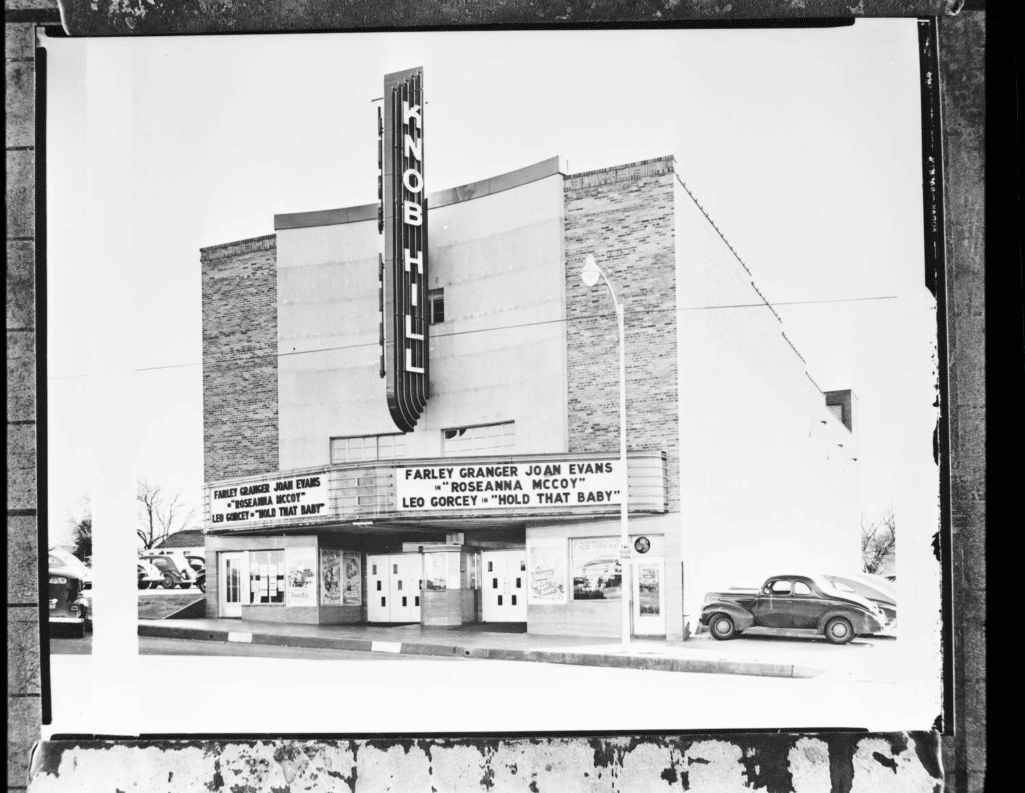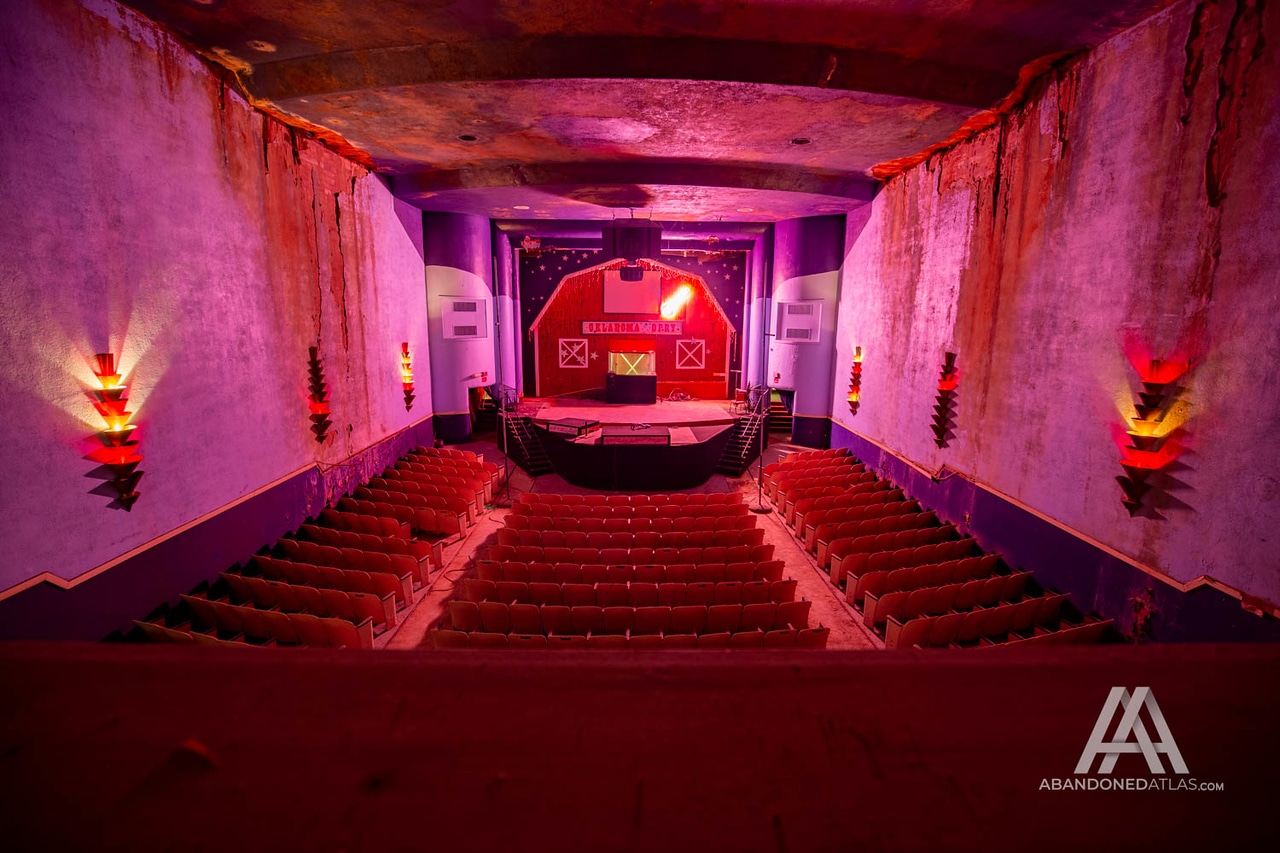| City/Town: • Oklahoma City |
| Location Class: • Theater |
| Built: • 1946 | Abandoned: • 2010 |
| Status: • Under Renovation |
| Photojournalist: • Michael Schwarz |
Documentary
Knob Hill Theater

Come down and experience Oklahoma City’s newest and finest suburban movie theatre! Construction on the state-of-the-art facilities has been on-going since September 18,1945 experiencing repeated delays and costing roughly $150,000. Local theater mogul R.L. Barton welcomes you all to join us for the grand opening on October 10th, 1946. The concession stand will be fully stocked with snacks for you and your family as you watch Blue Dahlia at 5:30 pm! Following will be The Well Groomed Bride and Hair Raising Hare.
Oklahoma City during the 1920s-1940s was experiencing a massive population boom. Throughout the 20-year period, the city boasted an increase of 113,000 residents. Oklahoma City became a haven for leisure family activities with roughly 70+ theaters across the city by the 1950s.
The theater featured the most modern facilities including 16-spring seating and a glass crying room so that mothers could still watch the film. It also featured a smoking room which was not entirely common in theaters back then. One of its most defining characteristics was a large vertical sign made of porcelain-enamel and lit with beautiful neon resembling that of the Redskin Theater nearby. A backlit marquee was in place to announce the pictures showing each night making this theater a beacon of light to those driving down Commerce Street. In addition 500 car parking lots were located nearby as well as street parking.
Many different local companies reveling in the growth of Oklahoma City came together to enhance this project. Builders Construction Co. was the general contractor with Bill Jensen overseeing. They made the theater entirely fireproof with almost no wood in the building except for just enough to fasten the trimming. A massive squirrel cage fan pulled warm air out of the theater and a cooling air came in. The plaster on the walls even contributed to the experience patrons had as it was a special formula that absorbed sound. Tenessee marble at the front of the show house was a brown that contrasted with the aluminum doors and Kasota marble was above the marquee.
For many years it served the community well giving young teens memories of first dates, giving children and parents memories of family movie nights and touching a soft spot that many don’t notice until something is gone. This theater, like many others, fell victim to the rise of television and cable TV. By the 1970s most family households had been able to purchase a TV having hit a boom some twenty years prior. But a new development, cable TV, proved to be another nail in the coffin of changing market trends. Roughly around 1976 the theater was no longer able to keep its doors open and shuttered. The once bright, and teaming with life entertainment venue because home to pigeons that found peace in the darkness and a party spot for neighborhood kids and amateur spray paint artists. The community held hopes that life would be breathed back into the dusty edifice and holding shows once again. Their hopes would soon come true.
Oklahoma Opry
The Oklahoma Opry, the brainchild of Grant Leftwich was formed in 1977 and was without a permanent home. Having done shows previously in the former National Guard Armory, they were on the hunt for something grand. That’s when they came across the former Knob Hill Theater in the almost deserted Capitol Hill business section. Leftwich had a vision, seeing past the imperfections he took a chance on the building with a mission to bring it back to life and make it the home of the Oklahoma Opry.
Banding together, more than 30 participants in the Opry got to work on the $8-10,000 of initial cleanup. Pigeons were evicted from their makeshift home and their droppings were shoveled out. Disinfection of the walls and floors as well as scrubbing of the years of grime and buildup commenced. Once finished roughly 450 gallons of paint were put throughout the building. A new roof was put on to replace the previous one which allowed water knee-deep in some areas to accumulate. Every night for almost two months members of the Opry held sewing parties to create bright red covers for the almost 610 seats throughout the theater.
Finally, enough work had been done to host an opening night on March 30, 1980, with two country music shows. The shows sold out quickly and ~250 patrons wanting a glimpse at the local talent had to be turned away. Grant Leftwich’s vision to bring gospel and bluegrass music to the Capitol Hill area was coming true one show at a time. Local merchant Len Odom saw the Opry as a chance at revitalization, “You got lots of people that’ll get exposure to Capitol Hill now. Its a major phase in the areas revitalization,” he said. “The prospect of more people in the area might cause stores to stay open on show nights and might bring more stores to the area,” he continued.
Within two years the Oklahoma Opry was given the title of fastest growing country music show in the southwest. Their mission was to give amateur and new artists the chance to perform in front of a live audience. This allowed them to not only garner their own fanbases but experience the difference between performing in a studio and performing live. But that’s not all that the Opry offered, they worked further to connect young talent to those big in the industry to help once amateur talent become big-time artists. Every Saturday afternoon auditions for the show were held with almost no requirements.
Backing the performers but definitely not overlooked is the eight-man band that set the stage each Friday and Saturday night. Back then Chip Honer was on the steel guitar, Lori Kent on bass, Larry Kent on lead, Gary McCray on rhythm, Jim Hoton on electric fiddle, Susan McGee on fiddle, Tom Russell on piano and David Short on drums. In addition to this professional setup occasional backup singers would make their appearance called the Opry Angels.
Thousands of performers walked through its doors putting on the show of a lifetime. Many stayed for decades and many more were able to take the connections, skills and experience they gathered at the Opry on to the next step in their career. Since its inception more than 10,000 performers have graced the stage. On any given Saturday there are about 12 acts, most being local and smaller artists to get their boots on the ground.
As the 2000s approached the Opry was entering a new era. Unfortunately founder Grant Leftwich fell ill and the decision to sell the building and Oklahoma Opry name was made in 1999 to Mac Teague. In 2002 Teague put in a next door recording studio that allowed stars to record music in-house. A brand new restaurant and snack bar was added and viewing screens fitted in various spots throughout the building. Leftwich and the existing team continued to stay employees.
At that time 200 artists and bands rotated through the company. Some of the biggest artists to come through the doors include Reba McEntire, Blake Shelton, Tim Rushlo, Bryan White and Tim Owen who wrote songs for Brad Paisley and others.
But times were changing, in 2004 after the season would come to a close Leftwich and the employees would lose their jobs. Teague would continue the Opry but its iconic country shows would become less frequent going once a month instead. Leftwich and his team would leave on a somber note though having creatly the Opry Heritage Foundation of Oklahoma and the Oklahoma Rodeo Opry to further their mission.
The Oklahoma Opry continues with shows until around 2010 when due to “personal issues amongst the owners” it shut down unexpectedly.
Watch this documentary that explains this mystery!
Nowaday the Oklahoma Opry is in Bricktown! Learn more at https://www.ohfo.org/
Gallery Below of Oklahoma Opry
https://www.newspapers.com/image/839702893/?terms=%22knob%20hill%20theater%22&match=1
https://www.newspapers.com/image/836509475/?terms=knob%20hill%20theatre&match=1
Knob Hill Theatre, photograph, 1949~; (https://gateway.okhistory.org/ark:/67531/metadc1551251/m1/1/?q=knob%20hill: accessed January 5, 2023), The Gateway to Oklahoma History, https://gateway.okhistory.org; crediting Oklahoma Historical Society.
https://www.newspapers.com/image/839706211/?terms=knob%20hill%20theatre&match=1&clipping_id=115845198
https://www.newspapers.com/image/839706215/?terms=knob%20hill%20theatre&match=1
https://www.newspapers.com/image/839706224/?terms=knob%20hill%20theatre&match=1
[Photograph 2012.201.B0354.0469], photograph, March 31, 1986; (https://gateway.okhistory.org/ark:/67531/metadc396109/m1/1/?q=%22oklahoma%20opry%22: accessed January 5, 2023), The Gateway to Oklahoma History, https://gateway.okhistory.org; crediting Oklahoma Historical Society.
https://www.newspapers.com/image/452411784/?terms=%22knob%20hill%20theater%22&match=1
https://www.newspapers.com/image/451844688/?terms=%22knob%20hill%20theater%22&match=1&clipping_id=115845256
https://www.newspapers.com/image/453931914/?terms=%22knob%20hill%20theater%22&match=1&clipping_id=115845319
https://www.newspapers.com/image/453919630/?terms=%22oklahoma%20opry%22&match=1
https://www.newspapers.com/image/455078530/?terms=%22oklahoma%20opry%22&match=1
https://www.newspapers.com/image/452793319/?terms=%22oklahoma%20opry%22&match=1
https://www.okgazette.com/oklahoma/historic-capitol-hill-continues-to-grow-as-the-district-is-revitalized/Content?oid=2979822
If you wish to support our current and future work, please consider making a donation or purchasing one of our many books. Any and all donations are appreciated.
Donate to our cause Check out our books!


















































































































































































































































Great photo set, my congratulations on capturing it. I had been wondering what the inside of the old theatre looked like after all these years. Brought back a lot of memories of what it looked like back in the 60’s when it was a theatre. Interesting to note, it was essentially identical to the old Redskin on 29th, which R. Lewis Barton also owned. . Looking at the projection booth, I recall every thing that used to be mounted on that wall. . Change overs, wiring runs, the Sound Amplifiers. . .
I had wondered what became of it, and thanks for answering that. I hate to hear how the old theatre died, and what happened with the OK Opry and Grant Leftwich. It is also sad to think that the old Knob Hill and the Yale are now the only theatres left in Capitol.
1 Aug 2023
I was house photographer at the Opry for about a year. Saw many new artists come through there. Remember Grant Leftwich fondly. So many memories there!
I performed at the Oklahoma Opry when I was a young girl in high school I believe I was either a junior or a senior in high school and I walked down that staircase in my prom dress because it was prom night So after I performed I went to my prom Great memories at the Oklahoma Opry ❤️❤️❤️❤️